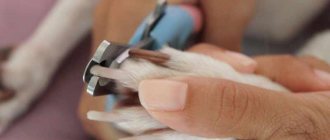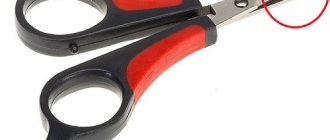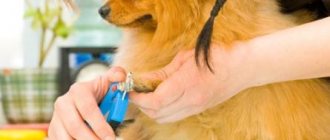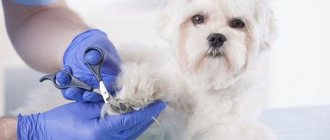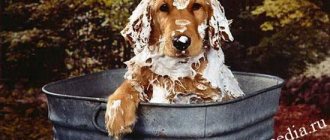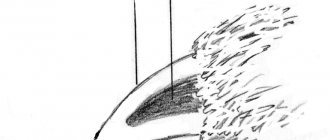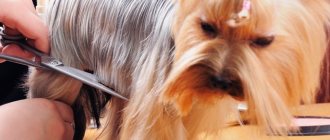Why are dogs' nails trimmed?
When a puppy appears in the house, he runs around, fools around and can accidentally catch his claw on the tulle or scratch the parquet. To avoid this, puppies' nails are trimmed regularly.
Small dogs' nails grow quickly. It is recommended to cut them once every 14 days. The weight of such pets is small and their claws do not wear off on their own, even on asphalt. If this is not done in time, the claw will become long, hard and can be split when trimmed. The dog will bleed and will need to stop it with a disinfectant.
Smooth-haired dogs' nails are easiest to trim, but long-haired dogs' nails are not so visible. It’s even more difficult if the claw of a long-haired dog is dark. Then it is also necessary to trim the fur between the pads in order to remove the claws without touching the blood vessels.
What does the price of the service depend on?
- Dog size : often all procedures performed by veterinarians on animals of large breeds are more expensive than in the case of small ones (for example, if the cost of cutting nails for dwarf decorative dogs in veterinary clinics in Moscow averages 250 rubles , then for a service for a large dog specialists will ask almost twice as much - 450 ! Naturally, we are talking about the same manipulations without any changes)
- Region in which the clinic is located : of course, enterprises located in the center of the capital will charge much more for the service than veterinary clinics on the outskirts or in the provinces. However, it’s worth starting from your place of residence - taking your pet for nail trimming far away just because “it’s cheaper there” is strange, to say the least.
- Ancillary services - in addition to trimming nails with filing, you can add shaving of the hair between the paw pads, as a result of which the price will double.
- The owner's help is also an important factor. Prices in most clinics are indicated precisely taking into account the fact that the owner will make efforts to ensure a static, motionless position of the pet’s body during the procedure. If there is no help from the owner, the cost of the service increases by 50%
- In many clinics in Moscow and the region there is where a full range of care procedures is added to nail trimming (cost approximately 2000 - 5000 rubles )
Considering that the service of trimming dog nails is one of the simplest procedures in the price lists of clinics, it differs little in different establishments: naturally, in price and quality, because in a more expensive clinic the pet can enjoy an attentive and caring attitude towards his person and skilled work.
Although, this does not mean that establishments providing a service costing 250-300 rubles (minimum price) are not suitable for using their help. In fact, no matter what the price category, a lot depends on the specialists, their attitude to their work and to animals.
Sometimes a high price means maximum comfort and perfect service. But there are also opposite cases, when a master does his job “carelessly” for a fabulous sum. Therefore, before you go with your pet for a nail trim, you should carefully study all the clinics within your reach, as well as consumer reviews.
Many owners are wondering: what to choose – an expensive private or “public” clinic with more affordable prices? In fact, it’s worth watching based on the impressions of other animal owners - there are both negative comments about expensive salons and “odes of praise” to simple clinics with a minimum price list of services and affordable prices.
Cost of the service in various institutions:
- Clinic "Vetritual" - 250 rubles.
- Clinic "Vettaim" - 250 rubles.
- “Akela” - 350 rub.
- "Zoo Academy" - 200.
- “Asvet” - 350 rub.
- “Hachiko” - 400 rub.
- "Vetmaster" -300.
- "Univet" -300.
- "Oryx" - 500.
- "Chance" - 300.
- "VetHelper" - 150.
- "Vetlekar" - 200.
- "Impulse" - 200.
- "Phoenix" -300.
- "Simba" - 300.
- "Alpha" - 800.
Anatomy of a dog's claws
There is pulp inside the claw. She's soft. It contains a blood vessel + many nerve endings. On top is the stratum corneum. He's solid.
Together with the claw, the blood vessel grows and lengthens. When the owner does not trim it in time, it will subsequently have to be cut off along with the blood vessel. Part of the pulp is injured. While walking, the dog can infect the wound and become infected with tetanus.
Where is it better to carry out the procedure: at home or in a veterinary clinic?
The choice of place for the procedure depends on the nature of the animal, the skills and mood of the owner.
If you don’t have enough experience yet, you can call a veterinarian at home. This will allow your dog's nails to be trimmed professionally, without unnecessary stress for the dog.
Expert opinion
Anna Abramenko
An avid dog lover. Experience in veterinary medicine since 2009.
Ask a Question
Your pet may not like a visit to the veterinary clinic - he will be afraid, nervous, and pay attention to other animals.
Tools for trimming claws
- For home use, small or medium nail clippers are often purchased.
- In veterinary clinics, professional tools are large nail clippers.
What tools does a veterinarian use to trim dog nails?
1. Nail clippers or trimmers are special scissors for trimming nails. They are sold in 2 types: in the form of nippers, like scissors, and rounded, sickle-shaped blades. You cannot cut it with simple scissors; they will split the claw.
2. A special file for treating your pet’s claws. The human will not take a strong stratum corneum.
3. Scissors with rounded tips. They are for cutting the fur located between the paw pads. This is the prevention of fungus formation.
4. Guillotine.
5. Machine or trimmer sharpener.
Dog nail trimming technology
How the dog should position itself while trimming its claws depends on its size:
- If the pet is small, then it can be comfortably placed on your lap. The body is held with 1 hand, and the other is cut.
- If the dog is large, then make a raised platform, place a rug on it, and place the dog on top. The owner sits down behind him, takes his front paw and carefully holds it behind his back, trimming his claws one by one.
Adviсe
There are many dog breeding forums on the Internet, where experienced breeders share their experiences in caring for pets. Here are some of them that may be useful to inexperienced owners:
- If the fur interferes with the clear visibility of the claw, it should be removed and only then trimmed.
- It is worth asking your family for help to hold your pet.
- You should be accustomed to the procedure from a young age, that is, puppyhood.
- Do not shout at the animal and do not hit it under any circumstances.
- It is worth understanding that trimming nails is not a whim, but a concern for the health of your pet.
In any case, before carrying out any procedures on a pet, a novice dog breeder should consult with specialists. Only they can give clear and correct instructions on how to trim nails so as not to harm the animal.
Step-by-step instructions at home
1. The owner takes the pet by the paw and holds it tightly. He holds his hand so that it goes forward and along the paw.
2. The person places his fingers under the paw pad, and with his thumb he holds the finger on which he is going to cut the claw.
3. Before pressing the nail clipper, the owner once again carefully checks whether he has installed it correctly in relation to the claw. There are models where the blade of the nail clipper is not very visible.
4. Carefully cuts off the excess keratinized layer. The vessel of the light-colored claw is clearly visible and the owner will not touch it. In dark ones, you need to cut layer by layer until a point is visible in the center - this is the beginning of the growth of a blood vessel.
5. After trimming each claw, the pet is rewarded with a treat. He will like it and will bear it more calmly.
6. After the first claw, 2 should be trimmed and all in turn. When the dog gets nervous and starts to pull out his paw, you need to let it go. The owner tenderly consoles the dog, scratches it behind the ear, gives it a treat, and soon continues the procedure.
7. When the claws are trimmed, they are properly processed on all sides with an abrasive file. They need to be smooth. After cutting, the edges will be uneven and quite sharp.
First aid for injuries
If a claw splits during trimming, most often a vessel will be hit and blood will flow. It needs to be stopped with one of the disinfectants.
Fits:
- hydrogen peroxide (3%);
- blood stopping pencil;
- iodine or potassium permanganate;
- corn starch or baby powder.
When the owner trims the claws, he places cotton pads, peroxide or a styptic pencil nearby on the bedside table or table. If the claw splits, pour a little peroxide onto a cotton pad and apply it to the bleeding wound.
Training to cut hair, praise and reward
It’s good when a dog is trained to trim its nails from puppyhood. An adult can be scared even when his paws are touched by a hand. Do not grab individual fingers or press on the nails.
What to do? At home, calmly take the paw in your hands and stroke it. Give a treat. This stage will take 2 days. Show the dog a nail clipper and get him used to the tool.
The nail clipper is used to touch the paw and the dog receives a treat. 2-3 minutes pass. and repeat everything, securing it with a tasty reward.
Briefly about the main thing
- It is best for a dog to undergo the procedure from childhood.
- You can trim your nails at home or in a veterinary clinic.
- Large nail clippers are the easiest way to cut a claw without it splitting, which happens when trimming is done with a small tool.
- At home, you should use a nail clipper and an abrasive file, and always keep a tasty treat on hand.
- In case of an accidental cut, the wound should be treated with hydrogen peroxide or iodine.
- You should accustom your dog to nail clipping through treats.
- The price for a haircut in a veterinary clinic starts from 200 rubles.
Required Tools
Experts do not recommend using ordinary scissors and clippers intended for humans. You can purchase a special nail clipper at pet stores and veterinary pharmacies. The tool is very convenient to use because one click is enough to remove excess length without damaging the surface of the plate. Store salespeople will help you choose the right tool, focusing on the size, shape of the claw and breed.
There are two types of nail clippers:
- Scissors-nippers - a design with two blades has different shapes: one is curved into a hook, the other is straight. The tool is equipped with two non-slip handles. Some models have limiters.
- A guillotine is a tool with one plate, which has a hole for a claw and a handle in the form of a lever. The guillotine is more dangerous, so it is rarely used at home - rather, it is a tool for professionals.
The owner should have several more devices at his disposal. So, a file is needed to trim cuts - you can use a rough model for human manicure. Small scissors with rounded edges will help remove hair between your fingers. Hydrogen peroxide, cotton pads and cotton swabs are needed to treat the emerging wound without interrupting the haircut.
All instruments are wiped with alcohol or peroxide immediately before the procedure, and hands are washed with soap. The animal should also disinfect its paws - lubricate them with peroxide or chlorhexidine.
